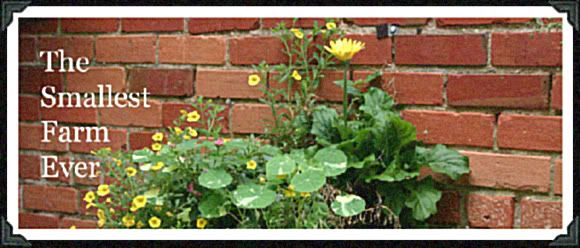
Living in our tiny little farm, I think about gardening a great deal. During our (usually) short and mild winters I peruse seed catalogs and long for the day of tomatoes and peppers. Last year was the first time that we grew things all the way through the winter months, which made me consider planting things that would be edible in the Spring.
I started it with a pack of seeds last year. We read all about planting peas, soaked them and prepared 4 large containers, and planted them on a nice day in March. Soon after a plaque of squirrels descended over our garden and unearthed all our peas. It took longer to plant them than for the little beasts to dig them up.
The following weekend, undeterred, we did it all over again. After carefully planting the seeds we asked Craig for some help and managed to cover our containers with chicken wire. We squealed with delight when the little plants poked their tendrils out of the earth. We built a nice trellis for them. And, soon after, we watched them wilt in the sun of one of the warmest Aprils ever. So much for peas.
This year we decided to be more aggresive. We had the peas in the ground by February 2, 2009. Two nights after planting the peas we had a hard frost. Since we didn't see any peas come up from that first planting, we assumed that the seedlings were killed by the frost. We replanted our pea beds on February 14th. We seeded Alaska peas from Ferry Morse that had been soaked overnight with a tablet of Vitamin C. The peas took a whole week to germinate, but they ended up coming up nicely. Since this year we had more rain and cold weather than ever I covered the pea beds with plastic everytime that there was frost in the forecast. Soon after planting the beds were filling up with plants and we built them a trellis from twigs, fashioned after a trellis that we saw at Colonial Williamsburg.
By May 14th we harvested our first peas. Our first day we picked up 6 oz of peas, which we proudly shelled and prepared with wilted lettuce. We have picked about 2 pounds of peas and served them as a side dish 4 times. Our peas are very sweet and very tender, and taste as good raw as they do when cooked.
The hot weather is getting to our pea plants, and the harvest may be coming to an end by next weekend. We will replant those beds with beans to have them growing this summer. I think the long, rainy spring had a lot to do with our success with the peas. It really has been fun to have them growing in the garden!
Here is a couple of ways that we prepared our peas this year:
My Mom's Peas and Potatoes
6-8 oz of peas, shelled
4 potatoes
4 strips of bacon
1/2 of a small onion
2 large cloves of garlic
olive oil, salt, and pepper
Peel the potatoes, cut them in quarters, and boil them in salted water for 10 min. Add the shelled peas to the boiling water and cook until the potatoes are done. Drain the water and put the peas and potatoes back in the pan.
Cut the bacon in small pieces, and fry it in a little olive oil with the chopped onion. When the onion gets lightly browned and the bacon is almost done, add the chopped garlic. As soon as the garlic starts to brown, season the peas and potatoes with salt and pepper and pour the bacon/onion/garlic mixture with the oil over them. Serve right away.
Sherry Castle's Tiny Green Peas
(I got this recipe at a cooking class with Sherry and changed it a bit to our taste)
2 cups shelled peas
1/2 cup chicken stock
2 tbsp butter
1 cup finely chopped lettuce
Salt and pepper
Blanch the peas in boiling water for 5 min. Drain. Cook the chicken stock in a saucepan until reduced by half. Add the peas and the butter. When the butter is melted, add the lettuce and stir until it wilts. Season with salt and pepper.



